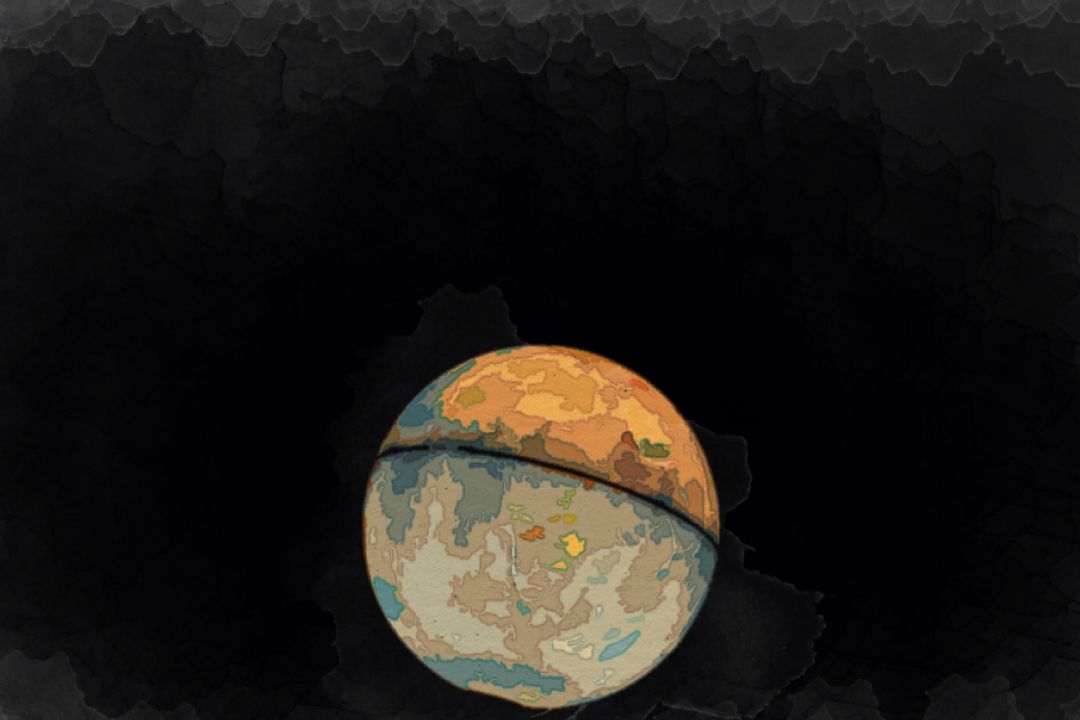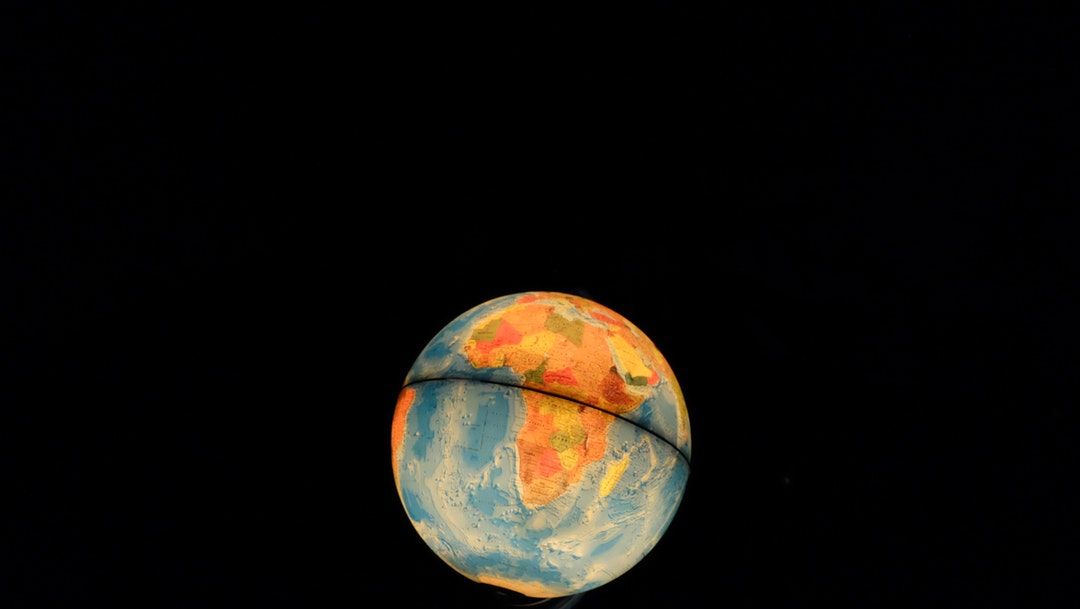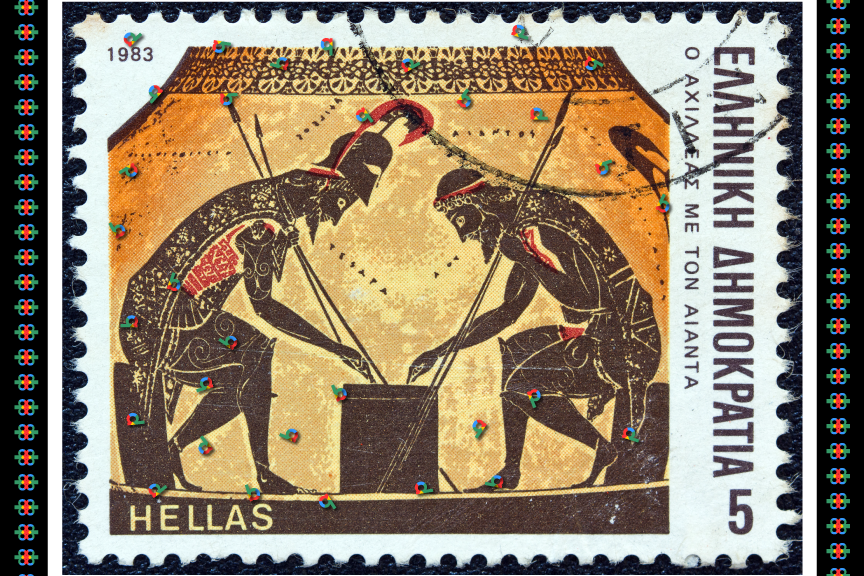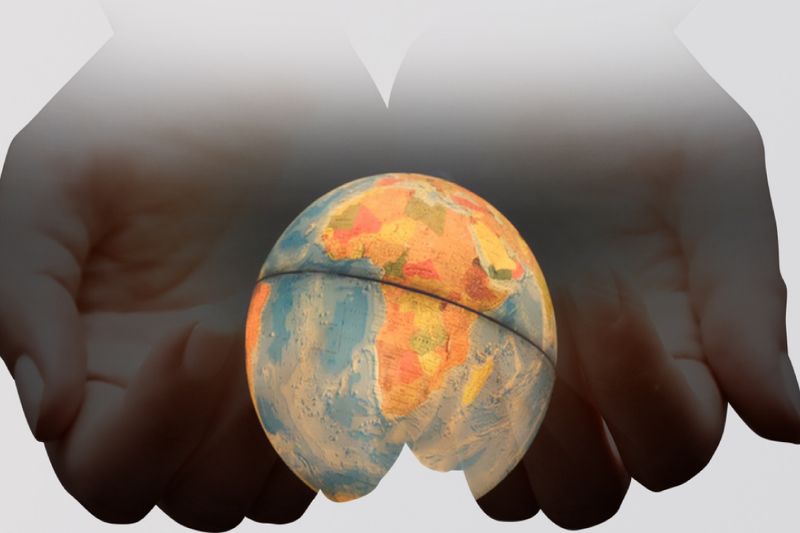Is the man the Father to the Grandfather?

Anthropomorphic Global Darkness
In the bustling heart of the city, Sophia stood before her latest installation, a kinetic sculpture of the globe. A whirl of colors swirled across the continents, a mélange of hues that captivated and intrigued. It was the eve of the unveiling, and her creation was to illuminate the city square, a beacon of anthropomorphic interpretation of the Earth suspended in a sea of urbanity. A smirk danced on her lips as she thought of the irony; her sphere was a globe yet undimmed by the patina of reality, a world still cradled in the purity of conception.
The child is father of the man.
— William Wordsworth (1770-1850)
These words, inscribed at the base of the installation, resonated with Sophia as she observed the children gathered around, their faces alight with wonder. In their eyes, the globe was not a mere assembly of gears and lights; it was magic, an orb of dreams and possibilities. Sophia mused on the notion that the purity and innocence of childhood informed the breadth and complexity of adulthood. Each child here today was an architect of tomorrow, and in their untainted enthusiasm, they fathered the adults they would become. This sculpture, she hoped, would plant seeds of inspiration that would burgeon throughout their lives.
Laughter and chatter permeated the air, yet within Sophia, a silence reigned—a contemplative quietude born of the myriad hours she had spent alone, crafting her vision into reality. The sight before her was a sharp contrast to the solitude of her studio, where the only sounds were the clinking of tools and the whisper of her own thoughts. It was there, in the cloistered embrace of her workshop, that she had grappled with the weight of creation, where the echoes of her own childhood dreams had spurred her on through the night. Each component of the globe was a testament to that journey, a piece of her past woven into the present.
In the dance of shadow and light that played over the globe's surface, the facets of her own being were reflected. There was the bright optimism of her youth, but also the deeper shades of trials overcome and lessons learned. For Sophia understood that to create, one must embrace the full spectrum of experience, accepting the darkness with the light. It was a realization that had come to her not in the throes of success, but in the quiet aftermath of failures—those silent teachers that had so often guided her hand.
In the eyes of the children, Sophia saw her legacy—a continuum of influence and imagination that would stretch far beyond the reaches of her own lifetime. As the city lights began to flicker on, her installation responded in kind, continents pulsing with a gentle luminescence. It was a microcosm of life, of energy, and of potential, a reminder that every human being held a universe within them, complex and radiant. And just as the globe itself was a caretaker of light, so too were these children guardians of the future.
As the night deepened, the globe took on a life of its own, a pulsating heart in the center of the city. Sophia stepped back, her creation no longer hers alone but now belonging to the world. She had set in motion a dialogue between humanity and its habitat, a conversation that would continue to evolve, to challenge, and to enchant.
The next day, Sophia returned to find her globe bathed in the soft light of dawn, its colors muted but alive in the gentle morning air. A hush lay over the city square, the previous night's revelry replaced by a tranquil serenity. It was in moments like these that she felt a deep connection to the world around her, to the earth itself with all its quiet majesty.
She sat on a nearby bench, taking in the sight of her globe as it stood sentinel to the waking city. Dew clung to the metal and glass, each droplet reflecting the burgeoning light, transforming the globe into a jeweled orb. It was during such moments of stillness that Sophia found clarity, her thoughts free to wander and alight upon memories long nestled in the recesses of her mind.
The very winds whispered in soothing accents, and maternal Nature bade me weep no more.
— Mary Shelley (1797-1851)
As a child, Sophia had found solace in the embrace of the natural world. When life's tempests raged, she would retreat into the woods behind her childhood home, where the wind through the leaves whispered secrets only she could understand. There was a rhythm to nature that soothed her, a timeless lullaby that promised renewal and rebirth. Even now, as an adult, the earth's tender murmurs coaxed forth tears she seldom allowed herself to shed.
These tears were not of sorrow but of connection, a profound sense of belonging to something greater than herself. It was this bond with nature that had imbued her art with life, that had led her to sculpt not just the shape of the world, but its essence. Sophia's globe was a testament to this relationship, a dialogue between creator and creation, between humanity and the earth.
As the city stirred, people began to populate the square, some stopping to gaze at the globe, others simply passing by on their way to the day's demands. Sophia watched them, each individual wrapped in their own narrative, yet all connected by the ground upon which they walked. It was this tapestry of life, of interconnected stories and shared spaces, that she strived to capture in her work.
A young boy approached, his eyes wide with curiosity. He circled the globe, his fingertips brushing against its surface as if to confirm its reality. Sophia observed him, recognizing the innate wonder that she herself had never lost. It was the same wonder that had driven her to spend countless hours with metals and gears, with wires and lights, weaving her homage to the planet.
The boy looked up at her, his gaze questioning. With a smile, Sophia knelt beside him, explaining the mechanics of the sculpture, the way it mirrored the rotation of the Earth, the meaning behind the colors and the movement. She spoke of the wind and the trees, of the ocean's depths and the mountain's heights, of the precious balance that sustained life.
She could see the gears turning in the boy's mind, his imagination alight with the possibilities of his own creations, his own contributions to the tapestry of life. In his bright eyes, she saw reflected the hope and potential of a future that was his to shape. It was a moment of profound recognition, a crossing of paths between two souls, each a guardian of the globe in their own right.
As the boy ran off, his laughter lingering in the air, Sophia felt a sense of accomplishment. Her globe was more than an object; it was an educator, a muse, and a bridge to the minds of the young and the hearts of the old. She stood up, dusting off her hands, ready to tackle her next project, secure in the knowledge that her work had ignited a spark that would burn brightly in the days to come.
The weeks passed, and Sophia's globe became a fixture of the city square, an anchor around which the daily life of the community swirled. The changing light of day and night revealed different facets of the globe, different aspects of the world it represented. Sophia would often visit, watching from afar, taking note of the interactions her work inspired. Each observation was a lesson, each reaction a mirror to the diverse tapestry of the human condition.
One evening, as twilight painted the sky in strokes of pink and indigo, she overheard a conversation between two passersby that gave her pause. They spoke of the globe, but there was a depth to their dialogue that transcended the mere artistic. They discussed the state of the world, the interplay of light and dark both on the globe's surface and in the world at large. It was a moment of serendipity, a glimpse into the private worlds of others, and it stirred something within her.
Knowing your own darkness is the best method for dealing with the darkness's of other people.
— Carl Jung (1875-1961)
Sophia reflected on this as she sat on her usual bench. She thought of her own struggles, the moments of doubt and fear that had threatened to overwhelm her during the creation process. It had been a journey of introspection, of confronting her own shadows to bring forth something that could stand in the light.
Her installation was not just a physical structure; it was a manifestation of her inner world, a world she had come to understand and accept. In the same way, the conversations it sparked were reflections of the inner worlds of others, their own struggles and triumphs, their personal dances with light and dark.
The recognition of her own darkness had been a cathartic experience for Sophia. It had allowed her to empathize more deeply with others, to understand that the ebbs and flows of the human psyche were universal. Her art had become a conduit for this understanding, a space where people could contemplate their own inner landscapes.
Sophia's musings were interrupted by the arrival of Alexander, an old friend and fellow artist, who approached with his usual buoyant stride. They exchanged pleasantries before he broached the subject that had clearly been on his mind.
"Your globe," he started, gesturing towards the installation, "it's become quite the conversation piece. I've heard people open up beside it in ways they never do otherwise. It's remarkable, really."
Sophia smiled, a wistful expression crossing her features. "It's strange," she confessed, "how sometimes it takes confronting the dark parts of ourselves to truly connect with others. To see that, reflected in my work, it's more than I could have hoped for."
Alexander nodded, understanding. "It's a rare gift, to create something that touches people so. But then, you've always had a knack for illuminating the dark, both in metal and in spirit."
The compliment warmed Sophia, a confirmation that her efforts to understand her own darkness had not been in vain. The globe was a beacon, yes, but also a mirror, reflecting the complexities of life back at those who gazed upon it.
As the night settled in, Sophia and Alexander sat side by side, two creators united by the shared language of art and human experience. Around them, the globe continued its silent revolution, a sentinel to the endless cycle of day and night, light and dark, understanding and mystery.
The city had grown around Sophia’s globe, seasons changing as the sphere remained an unchanging sentinel amidst the flux. Sophia found herself visiting less, yet her connection to the globe never waned. It had anchored her through a significant chapter of her life, and now it was time to seek new horizons. Still, the globe’s presence in the square drew her back for one last visit before her departure.
As she approached, she saw that the area around the globe had transformed. Where there once was just concrete and the occasional bench, now wildflowers bloomed, their colors a riotous echo of the globe’s own vibrant palette. Community gardens had sprung up, and children played among the foliage, their laughter a counterpoint to the city’s hustle.
It is a wholesome and necessary thing for us to turn again to the earth and in the contemplation of her beauties to know the sense of wonder and humility.
— Rachel Carson (1907-1964)
Sophia’s eyes traced the lines of children tracing the continents with their fingers, their parents nearby discussing the various plants now thriving around the square. The globe had sparked a return to nature, a reclamation of space in a concrete world. It wasn’t just a sculpture anymore; it was a catalyst for change, for reconnection with the planet it represented.
This moment was a culmination of Sophia’s hopes—a vivid representation of the cycle of influence that her work had set in motion. Here, in the heart of a once-grey city square, a microcosm of the earth had taken root. People had come together to create beauty, to share knowledge, and to foster a community spirit that Sophia had only dreamed of inspiring.
The sense of wonder and humility that Rachel Carson spoke of was alive in this space. It was in the hands of the children digging in the soil, in the careful tending of the gardeners, in the quiet contemplation of the passersby. Sophia felt a profound connection to all of it, a quiet pride that her art had played a part in this transformation.
She realized that her globe was not just a representation of the earth, but a reminder of our responsibility to it—a call to action that had been heeded. The installation had done more than illuminate; it had educated and inspired. It had brought people closer to nature, and in turn, closer to each other.
Sophia took a moment to speak with some of the gardeners, learning about their projects, their hopes for the future of the square. Their passion was infectious, and Sophia found herself laughing along with them, sharing in their joy and optimism.
As the sun began to dip below the skyline, casting a golden light over the square, Sophia said her goodbyes. She took one last look at the globe, now more alive than ever with the life teeming around it. It was a humbling sight, one that filled her with a profound sense of peace.
She turned to leave, her heart full of the memories that had begun with a simple sculpture and ended with a community united. Her steps were light, her spirit buoyed by the knowledge that her globe would continue to inspire long after she had moved on to new endeavors.
Sophia was ready for the next chapter, confident in the legacy she was leaving behind—a legacy of beauty, education, and a rekindled connection with the earth.
Months passed since Sophia had bid farewell to the globe and the city. She had traversed continents, seeking new inspirations and perspectives, her journey an ever-unfolding canvas of experiences. Yet, the globe and the lessons it imparted were never far from her mind. She had seen the beauty of the earth afresh through the eyes of different cultures and had found that, regardless of location, a universal thread connected them all—humor.
One evening, in a quiet village where the stars shone with an intensity she’d never before witnessed, Sophia found herself amidst an unexpected celebration. The villagers had a tradition, a festival of laughter, where every jest was a tribute to the folly of wisdom, and every chuckle a nod to the paradoxes of life.
Never have children, only grandchildren.
— Gore Vidal (1925-2012)
The phrase was part of a whimsical tale told by an elder, a statement met with roars of laughter that echoed through the night. The irony wasn’t lost on Sophia; it spoke of skipping the trials of parenthood and jumping straight to the joys of grandparenthood. But as the laughter died down, she pondered deeper, seeing the wisdom veiled within the jest.
It wasn’t about eschewing one stage of life for another; it was a comment on the nature of legacy. The globe, her 'child', had grown beyond her, leaving a legacy that, like grandchildren, carried forward her essence into the future. The art she created was a child of her mind, and the influence it had on people, the way it moved them to action, was its progeny.
Sophia embraced the humor, recognizing that it was often through laughter that truth shone most clearly. The stories shared that night, under the banner of stars, were filled with wit and wisdom, and Sophia absorbed them all, a mental tapestry she would carry with her.
The globe, which had begun as a somber reflection on the state of the world, had become a source of unity and joy, much like the laughter shared in that small village. It had brought people together, not in lamentation, but in action and hope. The notion of legacy had taken on a new dimension, one that intertwined with joy, community, and the ongoing dance of creation.
When Sophia returned to the city, it was with a renewed sense of purpose. The globe was as she left it, a beacon of color and life in the city square, surrounded now by an even lusher garden, with the echoes of children’s laughter bouncing off its surface. She approached, seeing not just a globe but a grandparent of change, its 'children' and 'grandchildren' the individuals it inspired and the actions they took.
Sophia’s art would continue to evolve, as would she. Each piece would be a 'child', each influenced individual a 'grandchild', extending the reach of her ideas and ideals. The cycle would continue, as would the laughter and the learning.
With a playful smile, she thought of the elder’s tale and the laughter it had sparked. Perhaps, she mused, the truest legacies are those that can find the humor in life, that can inspire a chuckle alongside change. She left the square that day with a lighter heart, her thoughts already dancing towards her next creation, her next contribution to the world's grand tapestry of joy and jest.
And with that, our narrative journey alongside Sophia and her globe, and the laughter and lessons they carried, comes to an end. If there’s anything more you’d like to explore or another adventure to embark on, just let me know.

The planksip Writers' Cooperative is proud to sponsor an exciting article rewriting competition where you can win part of over $750,000 in available prize money.
Figures of Speech Collection Personified
Our editorial instructions for your contest submission are simple: incorporate the quotes and imagery from the above article into your submission.
What emerges is entirely up to you!
Winners receive $500 per winning entry multiplied by the article's featured quotes. Our largest prize is $8,000 for rewriting the following article;

At planksip, we believe in changing the way people engage—at least, that's the Idea (ἰδέα). By becoming a member of our thought-provoking community, you'll have the chance to win incredible prizes and access our extensive network of media outlets, which will amplify your voice as a thought leader. Your membership truly matters!


